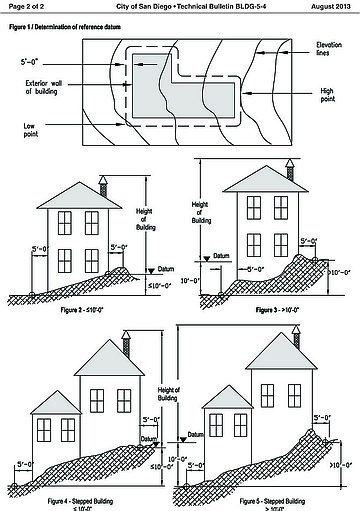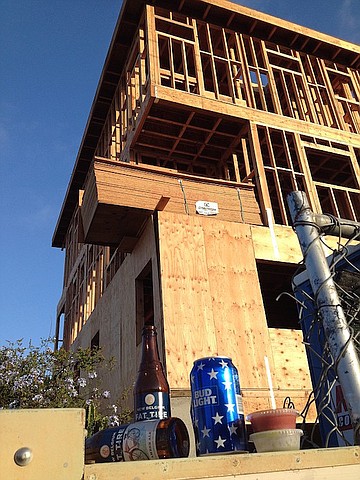 Facebook
Facebook
 X
X
 Instagram
Instagram
 TikTok
TikTok
 Youtube
Youtube

On August 24, a public notice for a September 8 hearing at San Diego's planning commission was posted online. (Update 9/8, 7:55 a.m.: On September 7, the notice was removed and the hearing postponed until September 22, following the publication of this article.)
“The hearing is to obtain a recommendation from the planning commission to the city council related to a municipal code change that will modify the zoning height limit for certain zones in the Peninsula community planning area that are also subject to the Coastal Height Overlay Zone,” said Katie Keach from the city's communications department.
On August 26, I contacted Point Loma Community Planning Board members Don Sevrens and Jon Linney, who have been knee-deep in coastal height issues since 2014 when they started seeing buildings over 30 feet spring up in Point Loma neighborhoods — all without going through their local planning group or the community, said Sevrens.
“The hearing came as a shock to us,” said Sevrens. “Every civil group was told about the hearing except for us. Apparently what’s happened is the mayor’s office has decided to do something by administration action because legislation takes longer. What they’re proposing is to fight the height limit, but on square footage versus actual height.”
According to both Linney and Sevrens, an August 2013 technical bulletin put out by the Development Services Department is the culprit. It attempts to reinterpret the over-40-year-old 30-foot coastal height limit.
In June 2016, as mayor Kevin Faulconer was seeking a second term, the brouhaha over builders running roughshod over the 30-foot coastal height limit came to a head. The catalyst was a construction site on the corner of Emerson and Evergreen streets in Point Loma — the mayor's neighborhood of residence.
The structure was clearly more than the allowed 30 feet, but the builder had that technical bulletin up his sleeve giving the nod to add a fourth-story and to bring in dirt to create a new ground-zero grade, fictitiously lopping off about ten feet from a structure over 40 feet tall. A protest and town-hall meeting followed that led to work being stopped.
Keach said that any change coming out of the September 8 hearing will not impact existing projects under construction — like the Emerson job — only future projects.

I asked Peninsula Community Planning Board member Jerry Lohla to talk about the loophole that was spawned by the 2013 technical bulletin. “I don’t think anyone knows with certainty what individuals are responsible, but ultimately the Development Services Department director is responsible because they put out the bulletin that allowed dirt to be piled on a site and then measured up 30 feet from that dirt pile.
“Also I would suggest that you not call it a loophole. A loophole can be legal, like loopholes with the IRS that you can take advantage of but are legal.
“Technical Bulletin 5-4 totally disregards Section 113.0270 of the Municipal Code in explaining how to determine reference datum for projects within the Coastal Height Limit Overlay Area. Robert Vacchi's [current development services director] lame reasoning is that the Proposition D language referenced the Uniform Building Code which was used in much of the western U.S. at the time Prop D was voted on [in 1972]. It seems unrealistic to think that in drafting the Prop D language, the city would have presumed that [building code] methodology would supersede the methodology of the city's municipal code.”
Why did this happen? “Ultimately, I think it’s because of influence of the development community. They’re always down at city hall pressuring development services to add as many square feet as possible. So they probably influenced the director of that time to interpret the requirements of Proposition D differently than our Point Loma community does.”
I asked the city who was responsible for the technical bulletin in 2013 as well as all three developmental services department directors from 2013 (Kelly Broughton, Tom Tomlinson, and Vacchi). Keach was the only one to respond, “The [development services] department took no action in 2013 that affected the Coastal Height limit.”
The city’s August 2013 technical bulletin may be a mystery as to specifically who authored it, but it’s less of a mystery as to how it happened when you look at it through the lens of the chaos that summer.
Besides the scandal that resulted in Mayor Bob Filner leaving office on August 30, there was the matter of shake-ups at both the city’s Development Services Department and planning department. The planning department that merged with the Development Services Department under Mayor Jerry Sanders in 2011 was being reconstituted by Filner that summer. His 2013 appointment of big-guns planner Bill Fulton for a dedicated director of city planning came on the heels of the developmental services director Broughton stepping down.
Tomlinson stepped in as interim developmental services department director in June 2013, which means he was in charge when the bulletin in question was published. He was replaced with Vacchi in December 2013 via an appointment from interim mayor Todd Gloria. The shake-up continued into 2014 with Fulton stepping down and with Mayor Faulconer’s attempts to privatize part of the planning department before finally appointing a new director in September 2015. Tomlinson is currently the assistant planning director.

On September 2, I went by the Emerson and Evergreen project site. No workmen to be seen, only bottles and cans of beer nearby a sign stating work hours and rules about workers not bringing intoxicating beverages onsite.
I also checked back in with another nearby construction site on Garrison and Locust. In June, there was a permit application to build four-story condos. The project architect said the permit was mistaken. Yet, on July 1 a grading and right-of-way permit was issued with the same scope of four-stories. A July 2 notation on the permit stated “no inspections allowed” and to ask Karen Flaherty for further clarification. Flaherty is a supervising plan review specialist with development services. She reports to Kerry Santoro who reports directly to Vacchi. Further clarification pending.


On August 24, a public notice for a September 8 hearing at San Diego's planning commission was posted online. (Update 9/8, 7:55 a.m.: On September 7, the notice was removed and the hearing postponed until September 22, following the publication of this article.)
“The hearing is to obtain a recommendation from the planning commission to the city council related to a municipal code change that will modify the zoning height limit for certain zones in the Peninsula community planning area that are also subject to the Coastal Height Overlay Zone,” said Katie Keach from the city's communications department.
On August 26, I contacted Point Loma Community Planning Board members Don Sevrens and Jon Linney, who have been knee-deep in coastal height issues since 2014 when they started seeing buildings over 30 feet spring up in Point Loma neighborhoods — all without going through their local planning group or the community, said Sevrens.
“The hearing came as a shock to us,” said Sevrens. “Every civil group was told about the hearing except for us. Apparently what’s happened is the mayor’s office has decided to do something by administration action because legislation takes longer. What they’re proposing is to fight the height limit, but on square footage versus actual height.”
According to both Linney and Sevrens, an August 2013 technical bulletin put out by the Development Services Department is the culprit. It attempts to reinterpret the over-40-year-old 30-foot coastal height limit.
In June 2016, as mayor Kevin Faulconer was seeking a second term, the brouhaha over builders running roughshod over the 30-foot coastal height limit came to a head. The catalyst was a construction site on the corner of Emerson and Evergreen streets in Point Loma — the mayor's neighborhood of residence.
The structure was clearly more than the allowed 30 feet, but the builder had that technical bulletin up his sleeve giving the nod to add a fourth-story and to bring in dirt to create a new ground-zero grade, fictitiously lopping off about ten feet from a structure over 40 feet tall. A protest and town-hall meeting followed that led to work being stopped.
Keach said that any change coming out of the September 8 hearing will not impact existing projects under construction — like the Emerson job — only future projects.

I asked Peninsula Community Planning Board member Jerry Lohla to talk about the loophole that was spawned by the 2013 technical bulletin. “I don’t think anyone knows with certainty what individuals are responsible, but ultimately the Development Services Department director is responsible because they put out the bulletin that allowed dirt to be piled on a site and then measured up 30 feet from that dirt pile.
“Also I would suggest that you not call it a loophole. A loophole can be legal, like loopholes with the IRS that you can take advantage of but are legal.
“Technical Bulletin 5-4 totally disregards Section 113.0270 of the Municipal Code in explaining how to determine reference datum for projects within the Coastal Height Limit Overlay Area. Robert Vacchi's [current development services director] lame reasoning is that the Proposition D language referenced the Uniform Building Code which was used in much of the western U.S. at the time Prop D was voted on [in 1972]. It seems unrealistic to think that in drafting the Prop D language, the city would have presumed that [building code] methodology would supersede the methodology of the city's municipal code.”
Why did this happen? “Ultimately, I think it’s because of influence of the development community. They’re always down at city hall pressuring development services to add as many square feet as possible. So they probably influenced the director of that time to interpret the requirements of Proposition D differently than our Point Loma community does.”
I asked the city who was responsible for the technical bulletin in 2013 as well as all three developmental services department directors from 2013 (Kelly Broughton, Tom Tomlinson, and Vacchi). Keach was the only one to respond, “The [development services] department took no action in 2013 that affected the Coastal Height limit.”
The city’s August 2013 technical bulletin may be a mystery as to specifically who authored it, but it’s less of a mystery as to how it happened when you look at it through the lens of the chaos that summer.
Besides the scandal that resulted in Mayor Bob Filner leaving office on August 30, there was the matter of shake-ups at both the city’s Development Services Department and planning department. The planning department that merged with the Development Services Department under Mayor Jerry Sanders in 2011 was being reconstituted by Filner that summer. His 2013 appointment of big-guns planner Bill Fulton for a dedicated director of city planning came on the heels of the developmental services director Broughton stepping down.
Tomlinson stepped in as interim developmental services department director in June 2013, which means he was in charge when the bulletin in question was published. He was replaced with Vacchi in December 2013 via an appointment from interim mayor Todd Gloria. The shake-up continued into 2014 with Fulton stepping down and with Mayor Faulconer’s attempts to privatize part of the planning department before finally appointing a new director in September 2015. Tomlinson is currently the assistant planning director.

On September 2, I went by the Emerson and Evergreen project site. No workmen to be seen, only bottles and cans of beer nearby a sign stating work hours and rules about workers not bringing intoxicating beverages onsite.
I also checked back in with another nearby construction site on Garrison and Locust. In June, there was a permit application to build four-story condos. The project architect said the permit was mistaken. Yet, on July 1 a grading and right-of-way permit was issued with the same scope of four-stories. A July 2 notation on the permit stated “no inspections allowed” and to ask Karen Flaherty for further clarification. Flaherty is a supervising plan review specialist with development services. She reports to Kerry Santoro who reports directly to Vacchi. Further clarification pending.
Comments